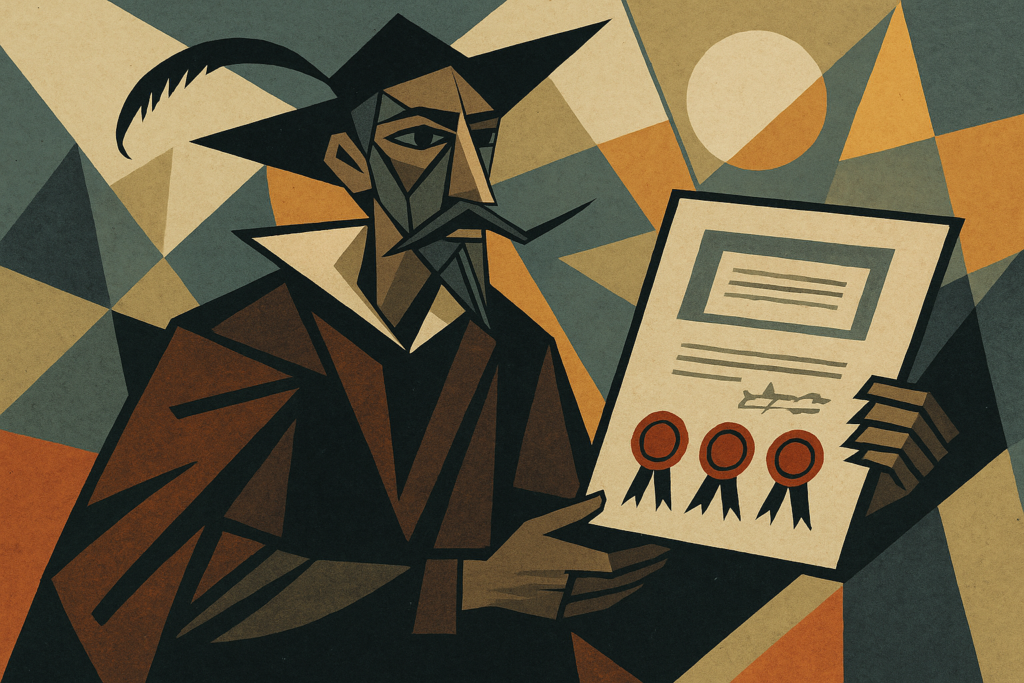Credentials, and their Origins

A man stands before the court in Valladolid, Spain, in the late sixteenth century. His boots are worn, his cloak patched. He carries more dignity than coin. In his hand is a parchment heavy with seals: his carta ejecutoria de hidalguía. It certifies what his purse cannot—that he is noble, an hidalgo. He may look like a beggar, but on paper he is a “son of something.”
Centuries later, a different setting, but the move is familiar. A university graduate uploads a résumé dense with acronyms. The HR rep cannot know her directly, but the watermark stands in. She too insists: I am credentialed, therefore I am qualified.
For centuries, this mechanism has repeated. Societies demand visible tokens of legitimacy. Credentials scale trust, certify merit, and verify honour—at least in theory.
The hidalgo’s parchment shows how brittle credentials once were. Don Quijote carried nobility but not the means to live it. Some turned this gap into business. One interesting story tells us about how an infamous hidalgo; Alonso de Camino (no relation), worked the seam between crown and province. He bought privileges directly from the monarchy, then resold them locally. In one celebrated deal he secured profits worth 300,000 ducats. That’s roughly seventy million euros today. His credentials allowed him to belong just enough to earn royal trust, yet also remain close enough to the peasantry to profit. Neither fully noble nor commoner, he extracted wealth from the in-between.
Today’s hedge-fund managers and financial engineers run the same play. The tools are different but the positioning and strategy are identical: profit in the space between recognition and reality.
Inheritance, Achievement, Industry
In Europe, the first credentials were inherited: coats of arms, family trees, titles at court. Religion added ordination papers and papal bulls. Universities followed with degrees that acted like passports. The Enlightenment shifted the idea: credentials became earned through exams and licences. Max Weber observed the modern office is built “upon written documents (‘files’ or ‘records’), which are preserved in their original or draft form“, and supported by a staff of officials.
By the twentieth century, credentials had become infrastructure. Professions multiplied certificates, corporations demanded diplomas, and in turn, our self-identity began to look like a résumé.
Underneath it all lies a neurological mechanism: humans outsource trust to symbols. The brain conserves energy by treating seals, titles, and diplomas as shortcuts—cognitive heuristics that stand in for lived proof. This distillation is why credentials largely persist: they compress complexity into a recognisable token. Yet when the signal falls out of step with reality, the gap becomes a place for profit.
Gatekeepers and Luxury Goods
Credentials have become one of the priciest “products” humans buy. A single degree can cost tens of thousands—and students often gamble decades in debt to earn the right to even start paying it back, with interest added on top. This generational crisis strains finances, health, and hope. Studies show a strong link between student loans and mental strain: one in 14 borrowers report suicidal ideation tied to debt, and that jumps to one in eight for those earning under $50K annually.
On the flip side, social media now sells the blue badge—no larger than a pinhead, yet priced above a Netflix subscription. Once reserved for public figures, it has become a monthly lease on legitimacy. No exam, no lineage, no learning—just an icon that declares: I am real. Credentialism boiled down to transaction, its proof or validation questionable at best.
The Futures of Trust
What lies ahead is further fragmentation. Micro-credentials, digital badges, and skill-tiles make trust modular. AI systems and digital platforms now verify competence in real time, loosening reliance on traditional paper. Yet scarcity still hardens at the top: Harvard and Oxford grow, their names acting more as brands first, knowledge second.
I’ve worked inside this shift for decades. In finance, media, software, and logistics, designing credential frameworks and content where academia had no answer with specifics. The Digital Designer Designation was built for this reason. It codifies the role of the creative generalist in digital media systems design, giving organisations a recognised standard where universities leave a vacuum.
And yet the pattern is old. The hidalgo’s parchment proved honour but not livelihood. Today, millions subscribe to badges while elite degrees grow rarer and more powerful. Credentials still democratise and stratify, dignify and expose. They are ladders and mirages at once.
The task is to see them clearly: signals, not destinies.
